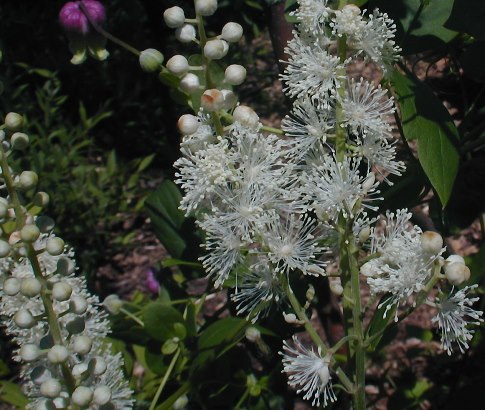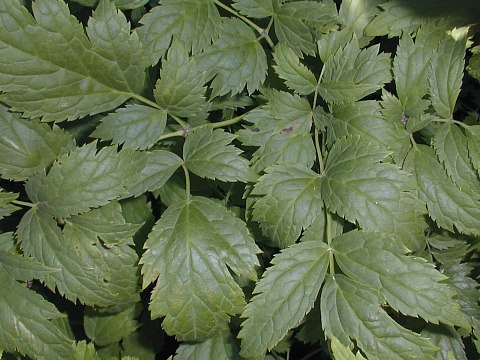Description: This herbaceous perennial wildflower is 3-7' tall. The stems are light green and hairless, while the large compound leaves are bipinnate or tripinnate with 10 or more leaflets. Usually 3 or 5 leaflets are grouped together in the ultimate partitions of each compound leaf. Individual leaflets are up to 4" long and 3" across; they are medium green, glabrous, and lanceolate to broadly ovate in shape. The margins of these leaflets are coarsely toothed; the terminal leaflets are often shallowly to deeply cleft.

Each plant
produces one or more panicles of racemes about 1-3' long. These
panicles are very narrow and produce only a few secondary racemes
around the central raceme. The racemes are narrowly cylindrical in
shape and erect; they are densely covered with flowers, buds, and
fruits (follicles) in varying stages of development (buds on top,
flowers in the middle, and fruits below). Individual flowers span about
2/3" across and they are completely white, consisting of about 24
stamens, a
single pistil, and insignificant sepals that drop early. The
slender stamens are long and conspicuous, while the pistil has a short
curved tip. Each
flower has a short pedicel. The blooming period occurs during early to
middle summer and lasts about 1½ months. The flowers have an
odd
unpleasant scent. Each flower is replaced by a small follicle about
1/3" long; this follicle has a beak that is very short and usually
curved. Each follicle splits open along one side to release several
seeds; these seeds are fairly smooth (not conspicuously scaly). The
root system is rhizomatous and fibrous.
Cultivation:
The preference is partial sun to medium shade, mesic conditions, and a
rich loamy soil with abundant organic material. This plant requires
plenty of space.
Range & Habitat:
The native Black Cohosh is rare in Illinois and state-listed as
'endangered.' It
has been found in only a few counties in northern and southern
Illinois. At some of these localities, Black Cohosh is probably
extirpated because it hasn't observed since the late 19th century. At
other localities, the population consists of plants that have been
introduced. Habitat includes mesic deciduous woodlands (where Sugar
Maple is often dominant) and the bases of bluffs along rivers. In
Illinois, Black Cohosh is more common in flower gardens than the wild;
it is also more common in natural areas further to the east, including
the Appalachian mountains.
Faunal Associations:
The flowers provide both nectar and pollen to insect visitors.
Unfortunately, these insects are largely unknown, in part because Black
Cohosh is uncommon in Illinois and neighboring states. The caterpillars
of the butterfly Celastrina neglecta major
(Appalachian Azure) feed exclusively on Black Cohosh; however, this
insect doesn't occur in Illinois. It is doubtful that mammalian
herbivores feed on this wildflower to any significant degree because
the foliage is toxic.
Photographic Location:
A flower garden at The Arboretum in Urbana, Illinois.
Comments:
This is one
of the largest woodland wildflowers. Black Cohosh is attractive as a
wildflower in part because it produces showy spikes of white flowers
during the summer, when there is little else in bloom in wooded
habitats. For this reason, it's a pity that this species isn't more
common within the state. There are two other species that Black Cohosh
can be confused with. One of them, Cimicifuga rubifolia
(Appalachian Bugbane), has leaflets up to 10" long and across that
often display a maple-leaf shape; it also has fewer than 10 leaflets
per compound leaf.

In contrast, Black Cohosh has smaller leaflets (up to 4" long and 3" across) and there are usually more than 10-20 leaflets per compound leaf. Another species, Cimicifuga americana (American Bugbane), has foliage that is nearly identical to that of Black Cohosh. However, American Bugbane has several pistils in the center of each flower, while Black Cohosh has only a single pistil per flower. Similarly, American Bugbane produces its follicles in clusters (one for each pistil), while Black Cohosh produces its follicles individually.